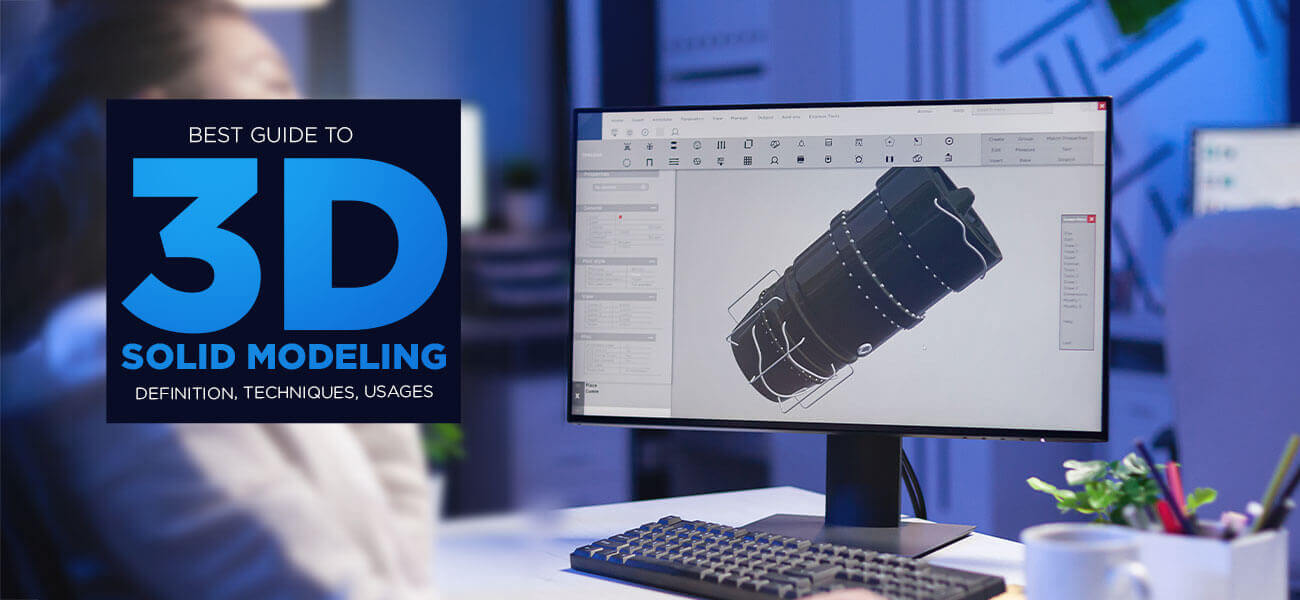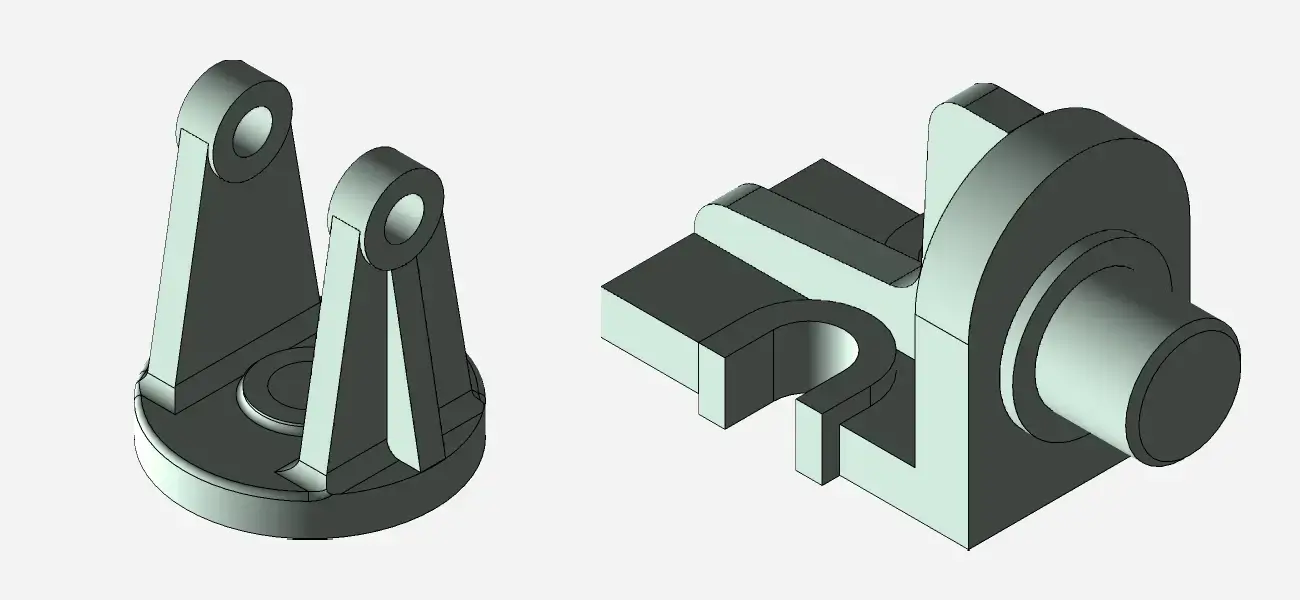Solid Modeling - Definition, Techniques and Applications

Are you a beginner who wants to try your hand at 3D solid modeling? Give this blog a read, which will give you all the necessary details about the solid modeling concept, how it is done, what its applications are, and how it is different from its surface modeling counterpart.
Without further ado, let’s begin!
What is Solid Modeling?

Solid modeling is a set of principles that utilize a bunch of tools to turn 2D drawings into solid 3D shapes. A solid model is a representation of the solid shapes which gives more topological and geometrical information of the object.
The simple and ideal definition of "solid modeling" will be that the process aims to keep all the surfaces geometrically accurate and requires the 3D CAD software to simulate the object externally and internally. This critical aspect makes 3D solid modeling hard to master.
What Are the Techniques Used in Solid Modeling?
There are 3 main solid 3D modeling techniques; each has its own distinct characteristics. The “parametric” features and range of operators differ in each technique that allow the 3D artists to manipulate and transform solid shapes.
-
Constructive Solid Geometry (CSG or C-Rep)
Constructive solid geometry technique is the most popular and widely used in creating solid models. In this approach, the model is created by utilizing 3D geometric entities called primitives. A mathematical set of boolean operations combines these entities and forms the desired model. The operations are union (ᴜ or +), intersection (I), and difference (-).
-
Pure Primitives
In this approach, objects with different geometry but similar topology are clustered under a common family known as a “generic primitive”. These primitives are defined in parametric group terms; for example, block primitives are defined by height (H), width (W), and depth (D). The 3D modeler needs to input these assigned parametric values and create the models.
Boundary Representation (B-Rep)
Boundary representation is another popular approach for solid modeling and is widely used by 3D modelers. In this, the model is created with the help of a set of faces. These faces bind a physical object, and each face is bound by the edges, which are surrounded by the vertices.
The Mathematical Foundations
For any 3D design to work perfectly, solid modeling is mandatory. Because apart from ensuring extreme geometrical accuracy, the approach also calculates complex engineering equations automatically, which are impossible to execute manually. These equations represent every aspect of a design and are therefore, pretty tricky.
So, in short, all the main tasks are essentially done by solid modeling to keep the aerodynamics of a racing car or an aircraft mathematically accurate. It is impossible for a product engineer to manufacture a product with functional consistency.
The Critical Elements in Solid Modeling
There are four main types of differentiating factors in solid modeling. These fundamental elements can be further defined as:
Complete: The several different points of an object within the 3D modeling environment can be categorized as inside or outside, which gives a more accurate representation of the object and its surfaces.
Valid: The modeling process is valid when all the vertices, faces, and edges are connected correctly, creating a complete view of the object.
Unambiguous: This implies a comprehensive interpretation of the object’s design aspects, indicating proper certainty and clarity in the design replicating real life functions.
Solid: This element is all about the geometric and topological data, such as weight, size, shape, and connectivity of nodes/faces/edges)
What are the Applications of Solid Modeling?
Initially created to be a planning and verification tool for machining and assembly, solid modeling has since evolved and has applications ranging from several mainstream industries.
Graphic designs
For generating customized 3D drawings, surfaces, 3D solid models, etc.
Product design
Parts and assemblies are represented in precise models using solid 3D modeling software. This allows designers to test the designed object as if it were a real manufactured product.
Manufacturing
Required for tool path generation and verification, dimension inspection, process planning, tolerance, and surface finish. Buyers can get models with all these specs met, to carry on with promotions even before the products are actually made.
Component Assembly
Solid modeling is leveraged for robotics development and flexible manufacturing, like vision algorithm, kinematics, planning and creating assembly sequences, dynamics, etc.
Solid Modelling vs Surface Modelling - Differences
Ever since the world saw the rise of 3D CAD technology, 3D modelers and CAD designers have become polarized regarding solid modeling and surface modeling. For some, solid modeling is their go-to option, and for others, surface modeling is the best choice. Following are some of the technical differences between the two; one may choose them based on the kind of design they are working on.
- Solid modeling involves a series of additive and subtractive operations to construct a model, ensuring an accurate calculable volume. Whereas the surface modeling process is about defining each face present in an object’s geometry to create the model.
- It utilizes mathematical equations to create 3D solid objects aimed at engineering research and analysis, computer graphics, CAD, 3D animations, etc. On the other hand, surface modeling represents various kinds of piecewise surfaces varying per their smoothness and shape.
- It defines the surface boundary of an object based on its topological details. This enables the modeler to determine the solid interior’s position on each surface point. In surface modeling, though, the modeler focuses only on the external aspects of the object, providing no topological details. This method only describes the object’s surface boundaries.
- It gives a more defined representation of the object’s intricacies that gives a better projection of its real life functionality. However, this is not possible in surface modeling, as the design is hollow from the inside. Hence, no intricate details are visible.
- As mentioned, solid models are parametric; this allows the modeler to review and tweak the commands used to develop the design, if required. Surface modeling, not being bound by parameters, makes any iteration time-consuming. One cannot change one part of the design and expect updations throughout the design.
Despite the differences, solid and surface modeling both have their uses and serve a great deal of purpose for 3D artists. Depending upon the design concept, gauge the competencies and limitations of each method and use them to reap benefits.
Hope you have now understood, that solid modeling is the most complicated and challenging of all 3D modeling methods and can be daunting for beginners.
So if you are a beginner, before plunging into CAD technologies, seek professional guidance and gain expertise. For enterprises in the manufacturing industry, it is always recommended that they reach out to a professional 3D modeling companies and let them create enticing 3D models.
Contact Us

